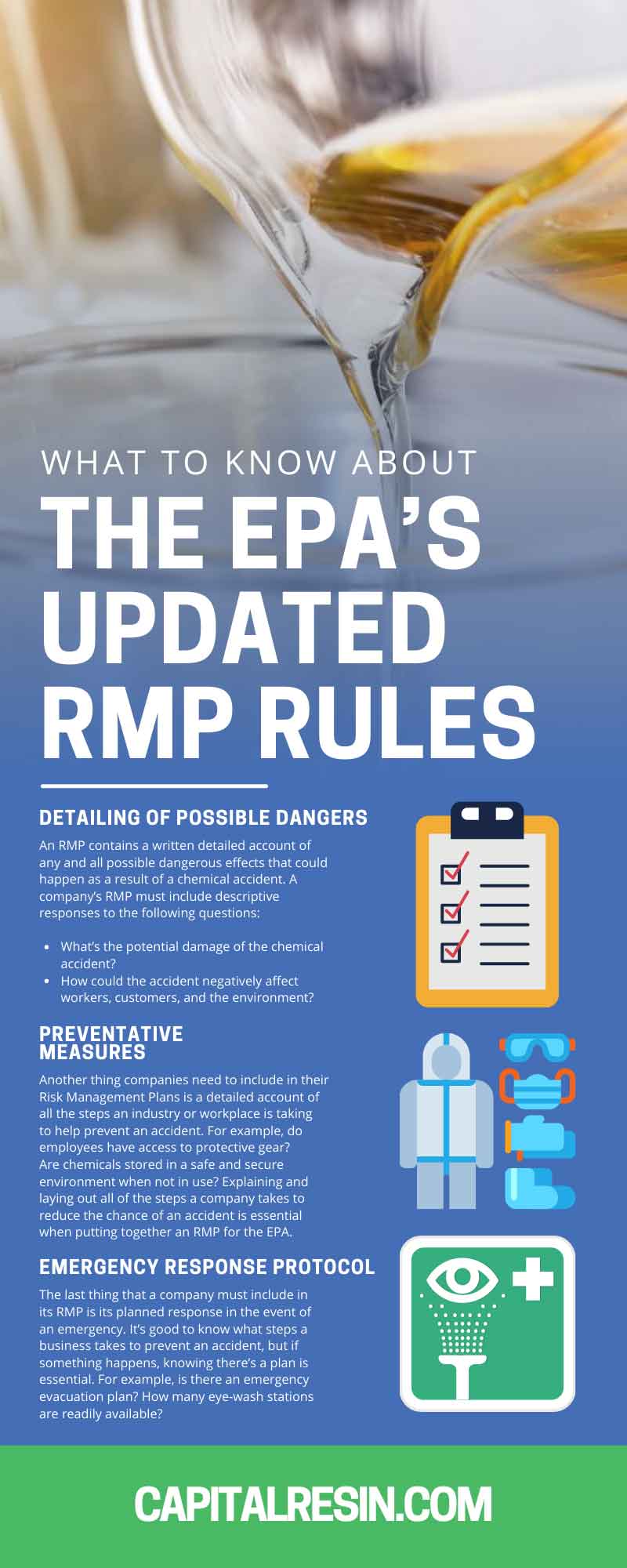The Environmental Protection Agency (EPA) is an independent agency in the United States government with the intent of protecting the environment from pollution, toxic chemicals, and other hazards. Richard Nixon created the agency in July 1970, and the organization launched later that year in December. The EPA helps ensure that US citizens have clean air and water by enforcing regulations over the production, use, distribution, and disposal of different chemicals.
The environmental protection agency launched its first Risk Management Program (RMP) rules in 1996. Since then, the EPA has updated the rules of these programs to ensure that companies are accountable and following proper procedures in modern times. The latest update to the rules went into effect toward the end of 2022. What do you need to know about the EPA’s updated RMP rules, and how might they affect you?
What Is a Risk Management Plan?
New updates to the RMP rules draw from section 112(r) of the Clean Air Act. The EPA requires published documents from facilities that utilize hazardous chemicals. The RMP rules state that facilities or industries that use hazardous chemicals must have a written, submitted, and approved Risk Management Plan.
Detailing of Possible Dangers
An RMP contains a written detailed account of any and all possible dangerous effects that could happen as a result of a chemical accident. A company’s RMP must include descriptive responses to the following questions:
- What’s the potential damage of the chemical accident?
- How could the accident negatively affect workers, customers, and the environment?
Therefore, a large part of creating an RMP is knowing and understanding the potential dangers of the chemicals you work with.
Accident Reports
Companies should also include a detailed accident report of any incidents that occurred within the past five years. This report not only allows for full transparency but also offers insight into potential threat levels, worst-case scenario situations, and guidance on preventing these types of accidents from happening again.
Preventative Measures
Another thing companies need to include in their Risk Management Plans is a detailed account of all the steps an industry or workplace is taking to help prevent an accident. For example, do employees have access to protective gear? Are chemicals stored in a safe and secure environment when not in use? Explaining and laying out all of the steps a company takes to reduce the chance of an accident is essential when putting together an RMP for the EPA.
Current Management and Training Procedures
Your RMP should include regular maintenance routines and details about how your company monitors and records information regarding the usage, transportation, and handling of potentially dangerous chemicals.
Your plan should also outline any and all employee training or preparedness measures that workers handling chemicals go through. Both written and hands-on training help ensure employees know what they’re working with and how to handle these chemicals safely and efficiently.
Emergency Response Protocol
The last thing that a company must include in its RMP is its planned response in the event of an emergency. It’s good to know what steps a business takes to prevent an accident, but if something happens, knowing there’s a plan is essential. For example, is there an emergency evacuation plan? How many eye-wash stations are readily available?
What Are the Benefits of Having an RMP?
Having a Risk Management Plan is a requirement for the EPA, but the plan is also greatly beneficial for other emergency services. For example, companies may want to pass these emergency reaction plans along to local police, fire, and emergency response services in the area. In addition, having a public RMP fosters trust and communication and helps ensure emergency responders know what to expect in case of an accident or other situation.
Who Needs To Submit an RMP?
Any facility holding regulated substances and chemicals above the EPA-approved threshold is legally required to submit a Risk Management Plan. The regulated substances and their threshold quantity are available on the Environmental Protection Agency’s official government website.
While the EPA is a federal organization, individual states may have specific laws regarding the handling and distribution of chemicals that differ from the EPA regulations. Remember to check local and state laws and include this information in your RMP when you submit it for approval.
How Often Do Companies Need To Submit an RMP?
Something to know about the EPA’s updated RMP rules is that they require companies to submit revised versions every five years. The new version should include details on any accidents that occurred throughout the last period, the cause of these accidents, and the proper emergency responses taken to address them. Companies or other entities should also include specific details on how the new plans and information differ from the previously submitted RMP. For example, changes in employee training, storage situations, and emergency preparedness should all be a part of the new Risk Management Plan.
How Can Companies Submit an RMP?
Companies may submit their Risk Management Plan through software available on the Environmental Protection Agency’s website. The EPA has software called RMPeSubmit that allows facilities to submit their plans for approval at any time. Companies may also use RMPeSubmit to correct, withdraw, or resubmit a plan for further editing, evaluating, or updating as necessary. This software is currently the only way for a facility to officially submit an RMP for EPA evaluation. However, businesses may contact the EPA directly in the event of any technical issues or to get more information on a specific query before including it in their submitted proposal.
Capital Resin understands the value and importance of transparency when working with potentially hazardous chemicals and has a solid RMP strategy that properly adheres to all Environmental Protection Agency standards. We strive to build trust between our clients and maintain a level of professionalism and emergency preparedness. Capital Resin has nearly 50 years of experience as a custom chemical manufacturer. If you need amino resins or chemicals made exclusively for your industry, let us handle your needs. You can rest easy trusting a company with an up-to-date RMP and strong reviews backed up by years of experience and knowledge. For more information on how Capital Resin can make your tomorrow better, please don’t hesitate to contact us anytime with any questions, comments, or concerns.








